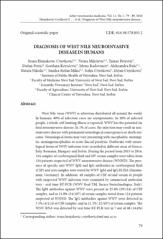| dc.contributor.author | Hrnjaković Cvjetković, Ivana | |
| dc.contributor.author | Milošević, Vesna | |
| dc.contributor.author | Petrović, Tamaš | |
| dc.contributor.author | Petrić, Dušan | |
| dc.contributor.author | Kovačević, Gordana | |
| dc.contributor.author | Radovanov, Jelena | |
| dc.contributor.author | Patić, Aleksandra | |
| dc.contributor.author | Nikolić, Nataša | |
| dc.contributor.author | Stefan Mikić, Sandra | |
| dc.contributor.author | Cvjetković, Sofija | |
| dc.contributor.author | Cvjetković, Dejan | |
| dc.date.accessioned | 2019-11-11T15:39:25Z | |
| dc.date.available | 2019-11-11T15:39:25Z | |
| dc.date.issued | 2018 | |
| dc.identifier.issn | 1820-9955 | |
| dc.identifier.uri | https://repo.niv.ns.ac.rs/xmlui/handle/123456789/147 | |
| dc.description.abstract | West Nile virus (WNV) is arbovirus distributed all around the world. In humans, 80% of infection cases are asymptomatic. In 20% of infected people, a febrile self-limiting illness is reported. WNV has the potential for fatal neuroinvasive disease. In 1% of cases, the infection may result in neuroinvasive disease with permanent neurological consequences or death outcome. Neurological forms may vary presenting with encephalitis, meningitis, meningoencephalitis or acute flaccid paralysis. Outbreaks with neurological forms of WNV infection were recorded in different areas of Greece, Italy, Romania, Hungary and Serbia. During the period from 2013 to 2016, 114 samples of cerebrospinal fluid and 107 serum samples were taken from 114 patients suspected of WNV neuroinvasive disease (WNND). The presence of specific anti-WNV IgM and IgG antibodies in cerebrospinal fluid (CSF) and sera samples were tested by WNV IgM and IgG ELISA (Euroimmun, Germany). In addition, 48 samples of CSF or/and serum of people with suspected WNV infection were examined by commercial molecular Tests - real time RT-PCR (WNV Real-TM, Sacace biotechnologies, Italy). The IgM antibodies against WNV were present in 25.4% (29/114) of CSF samples, and in 31.8% (34/107) of serum samples tested from 114 patients suspected of WNND. The IgG antibodies against WNV were detected in 3.5% (4/114) of CSF samples, and in 11.2% (12/107) of serum samples. The WNV RNA was detected by real time RT-PCR test in 7 out of 48 (14.6%) CSF or/and serum samples. In this study, detection of IgM antibodies in CSF is more frequent than detection of WNV RNA in CSF or serum samples. WNV RNA detection in CSF is confirmatory diagnostic test but has limited utility in the diagnosis of WNV neuroinvasive disease due to low viremia level at the time of clinical presentation of the disease. The limitations in the use of ELISA IgM test are linked to cross - reactivity among flaviviruses and long persistence of IgM antibodies in the serum and CSF. | en_US |
| dc.description.sponsorship | This work was financed by the Ministry of Education, Science and Technological Development, Republic of Serbia - projects TR31084 and III43007 | en_US |
| dc.language.iso | en | en_US |
| dc.publisher | Naučni institut za veterinarstvo "Novi Sad" | en_US |
| dc.source | Arhiv veterinarske medicine / Archives of veterinary medicine | sr |
| dc.subject | West Nile virus | en_US |
| dc.subject | ELISA IgM test | en_US |
| dc.subject | CSF | en_US |
| dc.subject | serum | en_US |
| dc.subject | real time RT-PCR | en_US |
| dc.subject | WNV genome | en_US |
| dc.title | Diagnosis of west Nile neuroinvasive disease in humans | en_US |
| dc.title.alternative | Dijagnostika neuroinvazivne forme bolesti Zapadnog Nila kod ljudi | en_US |
| dc.type | Article | en_US |
| dc.identifier.doi | 10.46784/e-avm.v11i1.19 | |

